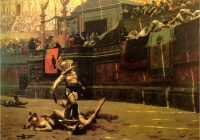Public space
From The Art and Popular Culture Encyclopedia
| Revision as of 11:14, 15 July 2014 Jahsonic (Talk | contribs) ← Previous diff |
Revision as of 07:56, 27 September 2020 Jahsonic (Talk | contribs) Next diff → |
||
| Line 1: | Line 1: | ||
| [[Image:Jean-Leon Gerome Pollice Verso.jpg|thumb|left|200px|''[[Pollice Verso (Gérôme)|Pollice Verso]]'' (1872) by Jean-Léon Gérôme]] | [[Image:Jean-Leon Gerome Pollice Verso.jpg|thumb|left|200px|''[[Pollice Verso (Gérôme)|Pollice Verso]]'' (1872) by Jean-Léon Gérôme]] | ||
| + | {| class="toccolours" style="float: left; margin-left: 1em; margin-right: 2em; font-size: 85%; background:#c6dbf7; color:black; width:30em; max-width: 40%;" cellspacing="5" | ||
| + | | style="text-align: left;" | | ||
| + | "[[Mass media|Media]], as we know it, first emerged at the beginning of the [[18th century|eighteenth century]]. Papers, journals, broadsheets, all became widely available in the new created [[public space]] of the [[coffeehouse]]. [...] The popular market for art and literature liberated writers and artists from the need for court [[patronage]]. No longer having to please their sponsors, they could experiment, and speak out as brashly as they wished." --''[[Counterculture Through the Ages]]'' (2004) by Ken Goffman, p. 162 | ||
| + | |} | ||
| [[Image:Nocturne au parc royal de Bruxelles by William Degouve de Nuncques.jpg|thumb|right|200px|''[[Nocturne au parc royal de Bruxelles]]'' ([[1897]]) - [[William Degouve de Nuncques]]]] | [[Image:Nocturne au parc royal de Bruxelles by William Degouve de Nuncques.jpg|thumb|right|200px|''[[Nocturne au parc royal de Bruxelles]]'' ([[1897]]) - [[William Degouve de Nuncques]]]] | ||
| [[Image:Sunday Afternoon on the Island of La Grande Jatte (1884-1886) - Seurat.jpg|thumb|right|200px|''[[A Sunday Afternoon on the Island of La Grande Jatte]]'' (1884-1886) - Georges Seurat]] | [[Image:Sunday Afternoon on the Island of La Grande Jatte (1884-1886) - Seurat.jpg|thumb|right|200px|''[[A Sunday Afternoon on the Island of La Grande Jatte]]'' (1884-1886) - Georges Seurat]] | ||
Revision as of 07:56, 27 September 2020

|
"Media, as we know it, first emerged at the beginning of the eighteenth century. Papers, journals, broadsheets, all became widely available in the new created public space of the coffeehouse. [...] The popular market for art and literature liberated writers and artists from the need for court patronage. No longer having to please their sponsors, they could experiment, and speak out as brashly as they wished." --Counterculture Through the Ages (2004) by Ken Goffman, p. 162 |
_-_Seurat.jpg)
|
Related e |
|
Featured: |
A public space is a social space that is generally open and accessible to people. Roads (including the pavement), public squares, parks and beaches are typically considered public space. Government buildings which are open to the public, such as public libraries are public space. Although not considered public space, privately owned buildings or property visible from sidewalks and public thoroughfares may affect the public visual landscape, for example, by outdoor advertising. Recently, the concept of Shared space has been advanced to enhance the experience of pedestrians in public space jointly used by automobiles and other vehicles.
Public space has also become something of a touchstone for critical theory in relation to philosophy, (urban) geography, visual art, cultural studies, social studies and urban design. The term 'public space' is also often misconstrued to mean other things such as 'gathering place', which is an element of the larger concept of social space.
One of the earliest examples of public spaces are commons. For example, no fees or paid tickets are required for entry. Non-government-owned malls are examples of 'private space' with the appearance of being 'public space'.
See also
- Busking
- Enclosure
- Footpath
- Freedom of panorama
- Guerrilla gardening
- Public art
- Public display of affection
- Public indecency
- Public land
- Public nudity
- Public sphere
- Speakers' Corner
- Street photography
- Third place (community)
- Urban design
- Village green


